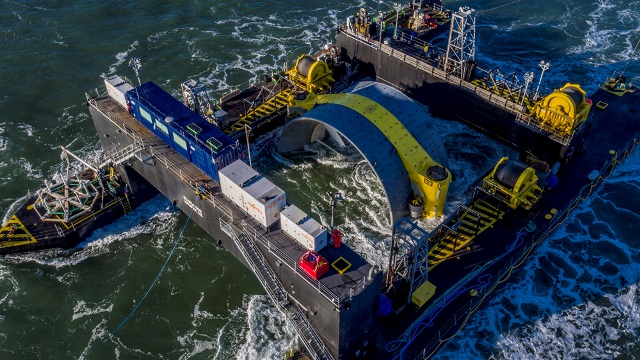
Tidal turbine deployed in Bay of Fundy after months of delay
by Cleantech Canada Staff

After a final weekend of preparation, the Emera and OpenHydro joint venture has sunk the first of two turbines off the Nova Scotia coast

The two megawatt tidal turbine was lowered to the seabed during a four-hour operation Nov. 7. PHOTO: Cape Sharp Tidal
HALIFAX—After months of delay and a four-hour ebb-tide operation, a 1,000-tonne tidal turbine is safely resting on the Bay of Fundy seabed.
Engineers had originally expected to install the towering piece of sub-sea hardware early this summer, but were delayed by a company decision to consult further with stakeholders and an attempt by the Bay of Fundy Inshore Fishermen’s Association to delay the project in court.
After a Supreme Court of Nova Scotia judge denied the court motion last month, however, Cape Sharp Tidal said it was finally prepared to put the turbine in the water.
The company announced Nov. 4 that pending any troublesome weather conditions, it would begin installing its first tidal turbine in the famed East Coast bay’s Minas Passage over the weekend. Though Cape Sharp elected to hold off for a short time to complete some last-minute maintenance on the turbine’s tail, it began sinking the two megawatt turbine early Monday morning off the coast of Parrsboro, N.S.
In the days leading up to deployment, Cape Sharp, which is a joint venture between Nova Scotia utility Emera Inc. and OpenHydro—a tidal turbine manufacturer owned by French industrial company DCNS—also committed to a number of new environmental monitoring initiatives to help assuage concerns that the turbines will negatively impact Bay of Fundy wildlife.
The company said tidal conditions in the Bay create a seven-day window for installation work twice each month.
After successfully sinking the turbine, crews will now turn their focus connecting it to previously-laid underwater power cables, which will allow it to deliver energy generated by the world’s most powerful tides to the province’s electricity grid.
Cape Sharp also intends to deploy a second sister turbine at the site at an unspecified time.
—With a file from The Canadian Press